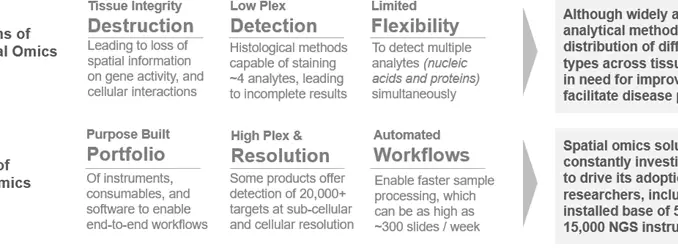
Recent advances in multi-omics approaches, including genomics, transcriptomics, proteomics, metabolomics, cytometry and imaging, in combination with bioinformatics and biostatistics, have been translated into several popular bioanalytical platforms, such as next-generation sequencing (NGS), single-cell analysis, flow cytometry and mass spectrometry. These platforms, although widely adopted, require tissue fixation and are therefore not capable of providing fundamental information about cellular interactions and biomarkers quantitative assessment. Furthermore, several live cell imaging and non-destructive fluorescence histological methods measure limited number of biomarkers at a time and the tags introduced may interfere with the natural function of genes and proteins. As a result, industry and non-industry stakeholders, are on the lookout for advanced platforms that can simultaneously capture the arrangement of multiple biomolecules (DNA, RNA, proteins and others) with single-cell or subcellular resolution. The up-and-coming field of spatial genomics in biology promises to bridge the gap between high plex, high throughput, and high resolution. Currently, several stakeholders are engaged in offering integrated solutions (platforms, software applications, services) to perform tissue analysis and spatial phenotyping, across the full continuum from discovery through translational and clinical research.
70+ spatial Genomics solutions are developed by industry and non-industry players
Presently, over 45 industry and non-industry players across the globe are engaged in the development of spatial omics solutions for spatial phenotyping and profiling of cellular landscape. These spatial solutions can support variety of tissue samples and can analyze different biomolecules such as DNA, RNA and protein utilizing multiple modes of imaging. Examples include CosMx Spatial Molecular Imager (NanoString Technologies), MERSCOPE platform (Vizgen) and PhenoImager- Fusion (Akoya Biosciences).

Several deals are Inked between 90+ industry and non-industry stakeholders in this domain
Majority of the collaborations 21%, inked by stakeholders in domain, were focused on the commercialization of spatial omics platforms / technologies. Examples of recently signed commercialization deals include (in reverse chronological order) collaboration between S2 Genomics and Mission Bio (April 2022), Ultivue and Standard BioTools (August 2021), 10x Genomics and Advanced Genomics Core (October 2020). The growing interest of spatial omics solutions providers to diversify their products portfolio and enhance the abilities of their existing instruments, has led to several deals inked for the integration of spatial omics solutions with the contemporary staining assays / reagents. In fact, platform integration agreements account for 18% of the total deals inked in this domain, since 2016. Examples of such instances include (in reverse chronological order) partnerships between Ultivue and Keen Eye (March 2022), NanoString Technologies and Leica Biosystems (February 2022), and Akoya Biosciences and PathAI (December 2021).

Likely Growth of the Spatial Omics Solutions Market
During our research, we estimated the market under conservative, base and optimistic scenarios. As per the base case forecast scenario, market for spatial omics solutions is estimated to be worth over USD XX billion, growing at an annualized rate of XX%, in the given time period. The opportunity is likely to be well distributed across type of solution, type of sample, end users, research areas and key geographical regions.

Presently, majority of revenues is generated from projects related to spatial transcriptomics and spatial proteomics (xx%). The trend is unlikely to change in the foreseen future.

Concluding Remarks
Since the completion of the Human Genome Project, the focus has shifted from decoding the linear arrangement of nucleotides to understanding the tissue structure and interaction of biomolecules, in spatial context. Over the years, several established players, as well as start-ups, have emerged in this domain to provide various types of spatial omics solutions, integrated with consumables and data analysis software. Currently, developed spatial analysis solutions offer several advantages with their diverse set of functionalities but they suffer from some technical limitations as well. Complex workflows, multiplex instrumentation, lack of standardized procedures and high cost hinders the broad adoption of these solutions. Given the ongoing technological advancements, spatial omics technologies are poised to become an integral aspect of life sciences labs in the future.
For more details on this emerging domain, check out the following report:
You may also be interested in the following titles:
- AI-based Drug Discovery Market (2nd Edition)
- CAR-T Cell Therapies: Intellectual Property Landscape
- Plant-based Meats: Intellectual Property Landscape
Our Social Media Platform
Web: https://www.rootsanalysis.com/
LinkedIn: https://in.linkedin.com/company/roots-analysis
Twitter: https://twitter.com/RootsAnalysis.com
Quora: https://rootsanalysisinsights.quora.com/
The post Spatial Genomics, Transcriptomics and Proteomics Solutions – An Amelioration of Tissue Analytics appeared first on Blog.
